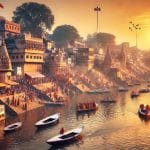Explore the spiritual and historic Ghats of Varanasi with our in-depth Guide to the Ghats of Varanasi. Discover the significance of Dashashwamedh, Assi, Manikarnika, and more. Plan your visit and experience the sacred essence of Varanasi.
Varanasi, one of the oldest living cities in the world, is famous for its ghats—sacred riverfront steps leading to the Ganges. These ghats are central to the city’s spiritual, cultural, and social life. Here’s a guide to some of the most significant ghats in Varanasi.

Dashashwamedh Ghat
The most prominent ghat, Dashashwamedh Ghat, is famous for the daily Ganga Aarti, a grand spiritual ceremony held every evening. Legend states that Lord Brahma performed a ten-horse sacrifice here, giving the ghat its name. It is an essential stop for visitors looking to experience Varanasi’s divine atmosphere Guide to the Ghats of Varanasi.
Manikarnika Ghat
One of the most sacred and oldest ghats, Manikarnika Ghat is known as a prime cremation site. Hindus believe that cremation here ensures liberation (moksha) from the cycle of rebirth. The ghat has an eternal flame that is said to have been burning for centuries.
Assi Ghat
Located at the southern end of Varanasi, Assi Ghat is popular among locals, pilgrims, and tourists alike. It is a serene spot, ideal for meditation and yoga. Morning aartis and boat rides from this ghat offer a peaceful experience of the city’s spiritual side.
Harishchandra Ghat
Another cremation ghat, Harishchandra Ghat is named after the legendary King Harishchandra, who worked here as a cremator to uphold truth and righteousness. It is considered second only to Manikarnika in importance for cremation rituals.
Panchganga Ghat
This ghat is believed to be where five sacred rivers—Ganga, Yamuna, Saraswati, Kirana, and Dhutapapa—converge. It is an ancient site mentioned in Hindu scriptures and is considered highly auspicious for spiritual seekers.
Also Read: Varanasi Ghats Tour: Exploring the Sacred Riverbanks
Kedar Ghat
Dedicated to Lord Shiva, Kedar Ghat is popular among devotees for its Kedareshwar Temple and its pure, holy water. Its South Indian architectural influence makes it distinct from other ghats in Varanasi.
Tulsi Ghat
Named after the saint-poet Tulsidas, who wrote the Ramcharitmanas, Tulsi Ghat holds historical and cultural significance. It is famous for its association with Ramleela performances and Sanskrit scholars.
Bhonsale Ghat
Built by the Bhonsale dynasty of Nagpur, this ghat stands out with its impressive architecture, including intricately carved temples and palatial structures.
Darbhanga Ghat
Known for its picturesque beauty, Darbhanga Ghat is home to the historic Darbhanga Palace, making it a favorite spot for photographers and tourists seeking tranquility.
Rana Mahal Ghat
Built by the Maharaja of Rajasthan, this ghat is an example of Rajput architecture and provides a scenic setting for spiritual contemplation.
Conclusion
Each ghat in Varanasi has a unique story and significance, collectively forming the spiritual heartbeat of the city. Whether you seek rituals, history, or a peaceful moment by the Ganges, these ghats offer an unforgettable experience in the sacred city of Varanasi.
Frequently Asked Questions (FAQs)
1. What is the best time to visit the ghats of Varanasi?
Early mornings and evenings are ideal, especially during the Ganga Aarti. Winter (October to March) offers the most pleasant weather.
2. Are boat rides available on the ghats?
Yes, boat rides are available from sunrise to sunset, offering a unique perspective of the ghats.
3. Is photography allowed at the ghats?
Photography is generally allowed, but it is advised to be respectful, especially at cremation sites like Manikarnika and Harishchandra Ghats.
4. Can I take part in the Ganga Aarti?
Yes, visitors can watch and participate in the aarti, but it’s best to arrive early for a good view.
5. Are there any restrictions for visitors at the cremation ghats?
While visitors are allowed to observe, it is important to be respectful and maintain silence.
6. Is swimming allowed in the Ganges?
Yes, but the water quality varies, and visitors should be cautious.
7. How do I reach the ghats?
The ghats are easily accessible by rickshaws, taxis, and walking. The nearest railway station is Varanasi Junction, and the airport is about 25 km away.
8. Are guided tours available?
Yes, guided walking tours and boat tours are available for a deeper understanding of the ghats’ history and significance.
9. What should I wear while visiting the ghats?
Modest clothing is recommended, especially when visiting temples or sacred sites.
10. Are there any good places to eat near the ghats?
Yes, several local eateries and cafés near the ghats offer delicious vegetarian food, including traditional Banarasi cuisine.




